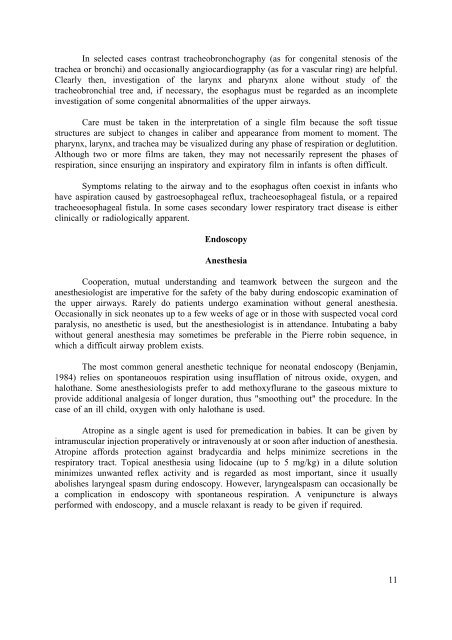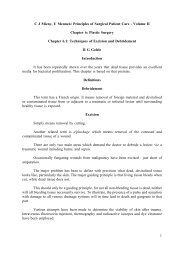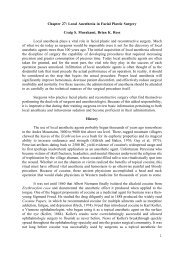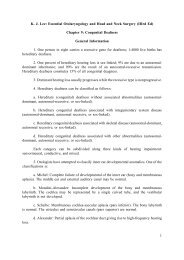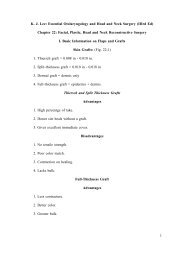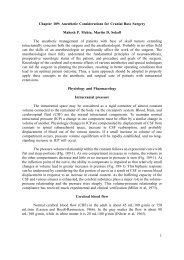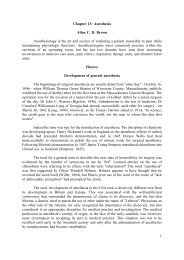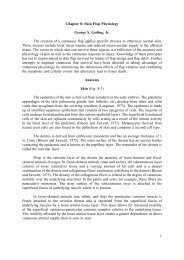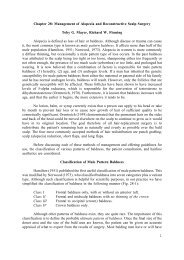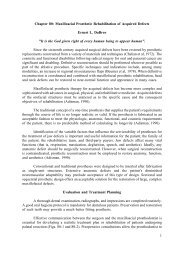1 Chapter 99: Congenital Disorders of the Larynx ... - Famona Site
1 Chapter 99: Congenital Disorders of the Larynx ... - Famona Site
1 Chapter 99: Congenital Disorders of the Larynx ... - Famona Site
Create successful ePaper yourself
Turn your PDF publications into a flip-book with our unique Google optimized e-Paper software.
In selected cases contrast tracheobronchography (as for congenital stenosis <strong>of</strong> <strong>the</strong><br />
trachea or bronchi) and occasionally angiocardiograpphy (as for a vascular ring) are helpful.<br />
Clearly <strong>the</strong>n, investigation <strong>of</strong> <strong>the</strong> larynx and pharynx alone without study <strong>of</strong> <strong>the</strong><br />
tracheobronchial tree and, if necessary, <strong>the</strong> esophagus must be regarded as an incomplete<br />
investigation <strong>of</strong> some congenital abnormalities <strong>of</strong> <strong>the</strong> upper airways.<br />
Care must be taken in <strong>the</strong> interpretation <strong>of</strong> a single film because <strong>the</strong> s<strong>of</strong>t tissue<br />
structures are subject to changes in caliber and appearance from moment to moment. The<br />
pharynx, larynx, and trachea may be visualized during any phase <strong>of</strong> respiration or deglutition.<br />
Although two or more films are taken, <strong>the</strong>y may not necessarily represent <strong>the</strong> phases <strong>of</strong><br />
respiration, since ensurijng an inspiratory and expiratory film in infants is <strong>of</strong>ten difficult.<br />
Symptoms relating to <strong>the</strong> airway and to <strong>the</strong> esophagus <strong>of</strong>ten coexist in infants who<br />
have aspiration caused by gastroesophageal reflux, tracheoesophageal fistula, or a repaired<br />
tracheoesophageal fistula. In some cases secondary lower respiratory tract disease is ei<strong>the</strong>r<br />
clinically or radiologically apparent.<br />
Endoscopy<br />
Anes<strong>the</strong>sia<br />
Cooperation, mutual understanding and teamwork between <strong>the</strong> surgeon and <strong>the</strong><br />
anes<strong>the</strong>siologist are imperative for <strong>the</strong> safety <strong>of</strong> <strong>the</strong> baby during endoscopic examination <strong>of</strong><br />
<strong>the</strong> upper airways. Rarely do patients undergo examination without general anes<strong>the</strong>sia.<br />
Occasionally in sick neonates up to a few weeks <strong>of</strong> age or in those with suspected vocal cord<br />
paralysis, no anes<strong>the</strong>tic is used, but <strong>the</strong> anes<strong>the</strong>siologist is in attendance. Intubating a baby<br />
without general anes<strong>the</strong>sia may sometimes be preferable in <strong>the</strong> Pierre robin sequence, in<br />
which a difficult airway problem exists.<br />
The most common general anes<strong>the</strong>tic technique for neonatal endoscopy (Benjamin,<br />
1984) relies on spontaneouos respiration using insufflation <strong>of</strong> nitrous oxide, oxygen, and<br />
halothane. Some anes<strong>the</strong>siologists prefer to add methoxyflurane to <strong>the</strong> gaseous mixture to<br />
provide additional analgesia <strong>of</strong> longer duration, thus "smoothing out" <strong>the</strong> procedure. In <strong>the</strong><br />
case <strong>of</strong> an ill child, oxygen with only halothane is used.<br />
Atropine as a single agent is used for premedication in babies. It can be given by<br />
intramuscular injection properatively or intravenously at or soon after induction <strong>of</strong> anes<strong>the</strong>sia.<br />
Atropine affords protection against bradycardia and helps minimize secretions in <strong>the</strong><br />
respiratory tract. Topical anes<strong>the</strong>sia using lidocaine (up to 5 mg/kg) in a dilute solution<br />
minimizes unwanted reflex activity and is regarded as most important, since it usually<br />
abolishes laryngeal spasm during endoscopy. However, laryngealspasm can occasionally be<br />
a complication in endoscopy with spontaneous respiration. A venipuncture is always<br />
performed with endoscopy, and a muscle relaxant is ready to be given if required.<br />
11


